Abîme de Bramabiau
Gorge of Bramabiau
Useful Information
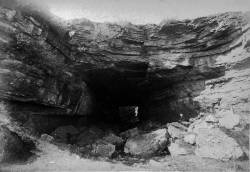
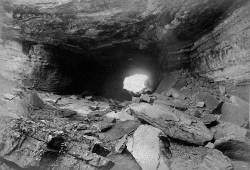
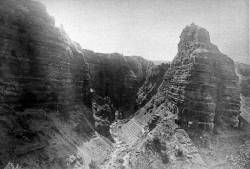
| Location: |
Route de Meyrueis, 30750 Saint-Sauveur-Camprieu.
Motorway A75 Clermont-Ferrand to Montpellier, exit 45 Millau, D986 towards L’Esperou. 50 km south of Florac. (44.1200621, 3.4751617) |
| Open: |
APR to JUN daily 10:30, 12, 13;30, 14:30, 15:30, 16:30. JUL to AUG daily 10-18. SEP daily 10:30, 12, 13;30, 14:30, 15:30, 16:30. OCT to 12-NOV daily 10-16. [2023] |
| Fee: |
Adults EUR 12, Children (13-16) EUR 9, Children (6-12) EUR 8, Children (0-5) free. Groups (20+): Adults EUR 3.50, Children (12-18) EUR 2.30, Children (-12) EUR 1.80. [2023] |
| Classification: |
 Karst Cave Karst Cave
 river cave. river cave.
|
| Light: |
 Electric Light Electric Light
|
| Dimension: | L=12,000 m, T=10 °C, A=1,126 m asl. |
| Guided tours: | L=1,000 m, D=60 min. V=40,000/a [2000] |
| Photography: | allowed |
| Accessibility: | no |
| Bibliography: |
E. A. Martel (1888):
Les Cévennes et la région des causses
Derek C. Ford (2015): The science of caves and karst: From the beginning of the Geological Society of America to ca. 1960, In book: Caves and Karst across time.Geological Society of America Special Paper 516Chapter: 1Publisher: Geological Society of AmericaEditors: Feinberg, J, Gao, Y, Alexander, E.C. researchgate DOI André Chamson (1933): L’Auberge de L’Abîme, Paris, Bernard Grasset, 1933, 298 pages. Daniel André, Michel Chabaud, Monique Puel (1988): Bramabiau, l’étrangeté souterraine, imprimeri Causses et Cévennes (Millau), p. 62-63. 
|
| Address: |
Abîme de Bramabiau, Route de Meyrueis, 30750 Saint-Sauveur-Camprieu, Tel: +33-467-826078.
E-mail: |
| As far as we know this information was accurate when it was published (see years in brackets), but may have changed since then. Please check rates and details directly with the companies in question if you need more recent info. |
|
History
| SEP-1884 | sink and cave first visited by E. A. Martel but not entered due to lack of equipment and experience. |
| 27 + 28-JUN-1888 | explored by
 E. A. Martel. E. A. Martel.
|
| 1890-1895 | exploration continued by Félix Mazauric, teacher at Champrieu, who explored 6 km of passages, and made a survey and map. |
| 1924 | Henri de Lapierre discoveres a albyrinth which was later named after him. |
| 1925 | opened as a show cave by the speleologist Aimé Cazal (*1897-✝1985). |
| 1929 | Aimé Cazal fakes the disappearance of three students in the cave in order to attract journalists there. |
| 1940s | declare a Natural Monument. |
| 1951 | exploration by Pierre Maréchal. |
| 1982 | exploration by the cavers Daniel André, Serge Gailhac and Monique Puel. |
| 20-MAR-1983 | the three discover the réseau Félix-Mazauric. |
| 2003 | Jean Truel creates modern cave paintings in the cave. |
| 2006 | cave trail and light renovated. |
Description
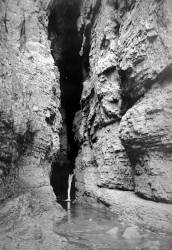
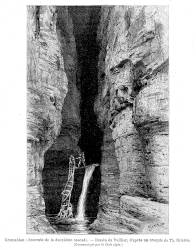
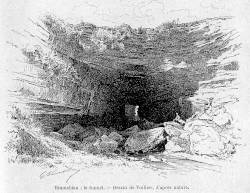
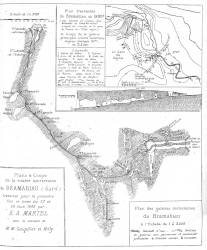
The Abîme de Bramabiau (Abyss of Bramabiau), in Occitan avenc de Bramabuòu is a river cave. Bramabiau (actually bramabuòu) is a word of the local Occitan dialect meaning roaring ox. This is a very old name, and describes the roaring sound the water makes during times of high water, when a spectacular waterfall leaves the resurgence. The cave entrance is a resurgence at the end of a 120 m deep gorge of the Bramabiau river, the cave passage is 70 m high at the entrance, but only a few meters wide.
The Bonheur (Happiness) river has its spring near the observatory Mont Aïgoual at the border of the Cévennes. This area is not karstified, as it does not consist of limestone, and the river flows on the surface. After 6 km it reaches the small karst area Causse de Camprieu and immediately enters the underground. The river vanishes in a huge cave and forms a subterranean gorge. It reappears after 500 m as the crow flies, and now the name of the river has changed, it is now called Bramabiau.
This situation is really typical for karst areas.
The river Bonheur forms a so called
 Polje, a valley without a surface drainage.
The drainage is underground, by a
Polje, a valley without a surface drainage.
The drainage is underground, by a
 Ponor
or swallow hole, which swallows the water of the river, called Perte du Bonheur.
Later the water reappears in a huge resurgence.
Ponor
or swallow hole, which swallows the water of the river, called Perte du Bonheur.
Later the water reappears in a huge resurgence.
In this case the whole cave is really spectacular, and it is a river cave or underground gorge with air, not submerged.
Both entrances of the cave are huge and easy to see, well known to the locals for a very long time.
But despite some prehistoric remains in a side branch, it seems the cave was never really explored, as the wild and dangerous water prohibited this.
At least until the end of the 19th century, when
 E. A. Martel
started his cave explorations.
He was on a holiday trip in this area, and was curious about this spectacular cave, and so he persuaded some friend to explore this underground gorge with him.
He visited several caves before, but this was the first speleological tour.
This day, the 27th June 1888 is called the birthday of modern speleology.
E. A. Martel
started his cave explorations.
He was on a holiday trip in this area, and was curious about this spectacular cave, and so he persuaded some friend to explore this underground gorge with him.
He visited several caves before, but this was the first speleological tour.
This day, the 27th June 1888 is called the birthday of modern speleology.
The locals were baffled when the horse-drawn carriages loaded with men and material arrived in Camprieu with loud noises. They laughed at these gentlemen from Paris and found their plan extremely strange. It was clear that no one could succeed, they thought Martel and his cronies were crazy and laughed at them. They told the story of a local named Vidal, also called La Trouche (the hole), who disappeared in the Perte du Bonheur on 7th February of the same year. If it was suicide or accident was unknown, but his body was never found. This was the proof of the inviolability of the mysterious underground!
Martel first tried to follow the river uphill, from the Bramabiau entrance. This worked rather well, until they reached the waterfall number six. Here his equipment was not sufficient to climb it, and the party turned around. The other day another attempt was made, this time they tried it from the Perte du Bonheur downhill, and soon they reached waterfall six, where they turned around the day before. From this side it was easier to follow the water, but nevertheless it was dangerous. And it was the first time someone did something like this, the first documented canyoning trip ever. It was the beginning of a long list of discoveries, by Martel and his companions.
"Bramabiau est une de ces oeuvres grandioses et bizarres que la nature exécute à coups de siècles et qui confondent l’esprit humain."
"Bramabiau is one of those grandiose and bizarre works that nature executes over centuries and that baffle the human mind.
E. A. Martel
Today the underground gorge is equipped with a comfortable path high above the cave river, today’s visitor does not have to walk through the water. Still it’s a long walk, first down into the valley of Bramabiau, then following the river upwards to the cave entrance. Inside the cave a path follows the gorge, then up to a higher and dry level of the cave and leaving the cave through an artifical tunnel. From here a trail leads back to the entrance. The tour does not cross the cave, as Martel did, but it is easily possible to visit the other side of the cave. In summer, when the river has little water, it vanishes in the ground before it reaches the cave entrance, and it is possible to follow the cave for a short distance. There are two big and several small sinks, the biggest is a huge cave called Perte du Bonheur. The 100 m long tunnel is easy to cross at low water, to reach a huge collapse doline where the ceiling of the cave had collapsed forming a pit vertical walls. The oval doline named Aven du Balset is 40 m long and 20 m wide. On the opposite side the cave continues, and here the trail soon becomes too difficult to follow without appropriate equipment.
The cave is one of the most famous caves on earth, because of the Martel story, at least among speleologists. But it is also a very impressive tourist destination, and well worth a visit. The tour starts at the parking lot at the D986, where the ticket office and a restaurant are located. From here it’s a 1.2 km hike to the cave entrance, then about 1 km in the cave, and 500 m back to the ticket office. On the way back there is a trail to the left, which leads through a cave to a spectacular outlook into the gorge, a detour of about 300 m. Another detour is on the right side, the trail leads to the Perte du Bonheur and adds another 860 m to the walking distance. While the official time of the tour is given with 1 hour, this is only the time inside the cave, we guess you should plan three hours to see all those sites. Also, be aware that the starting time of the tour is at the cave entrance, and there is a 20-minute walk to get there!
There are two pictures of this entrance on this page, one is a historic photograph from 1884, it was taken before the cave was explored. The photographer was Chabanon, who visited the site together with Martel in 1884. The other is an engraving which was made by Lucien Rudaux, his frequent companion on cave tours, and was published in the book E. A. Martel (1888): Les Cévennes et la région des causses.
And finally a word about a modern artwork in the cave, cave paintings by Jean Truel. When the trail leaves the gorge and ascends to the fossil level of the cave, there is a group of huge boulders. With no speleothems, the surface was used by the artist to create modern cave paintings. This was quite bold, and he received a lot of scolding for it. Today cave are considered protected natural monuments and any paint is considered grafitti. There are projects concerning art in caves now and then, but all are designed to place sculpures or probably light art inside the cave for some time and then remove it again, without any destructions. But paint on the walls will stay, probably for a very long time considering the age of prehistoric paintings. On the other hand, people destroy caves all the time, by quarrying, by stealing speleothems, by building trails for show caves inside, so why is a minimal "destruction" for art so unthinkable? The show cave operator, though bold enough to allow the painings, was obviously overwhelmed by the scolding, and the paintings are thus not even mentioned on the web page or by the cave guides. However, we agree with Franz Lindenmayr that this place should be highlighted with special lighting and proudly presented to the cave visitors. We therefore recommend Franz’s informative page on this subject.
The cave was actually inspiration for many artists. The novel L’Auberge de L’Abîme was written by André Chamson in 1933, and ten years later Willy Rozier realized it as a movie.
- See also
 Member of the International Show Caves Association (ISCA)
Member of the International Show Caves Association (ISCA) Search DuckDuckGo for "Bramabiau cave"
Search DuckDuckGo for "Bramabiau cave" Google Earth Placemark: Abîme de Bramabiau
Google Earth Placemark: Abîme de Bramabiau Google Earth Placemark: Abîme de Bramabiau (exit)
Google Earth Placemark: Abîme de Bramabiau (exit) Google Earth Placemark: Perte du Bonheur
Google Earth Placemark: Perte du Bonheur Abîme de Bramabiau
Abîme de Bramabiau  - Wikipedia (visited: 09-FEB-2023)
- Wikipedia (visited: 09-FEB-2023) Abîme de Bramabiau, official website (visited: 09-FEB-2023)
Abîme de Bramabiau, official website (visited: 09-FEB-2023) Bramabiau’s abyss (visited: 09-FEB-2023)
Bramabiau’s abyss (visited: 09-FEB-2023) L’Abîme de Bramabiau several explanations, pictures and info
L’Abîme de Bramabiau several explanations, pictures and info  (visited: 09-FEB-2023)
(visited: 09-FEB-2023) Bramabiau, F by Franz Lindenmayr
Bramabiau, F by Franz Lindenmayr  (visited: 09-FEB-2023)
(visited: 09-FEB-2023) Jean Truel - der echte Erbe der Höhlenmaler? by Franz Lindenmayr
Jean Truel - der echte Erbe der Höhlenmaler? by Franz Lindenmayr  (visited: 09-FEB-2023)
(visited: 09-FEB-2023)
 Index
Index Topics
Topics Hierarchical
Hierarchical Countries
Countries Maps
Maps